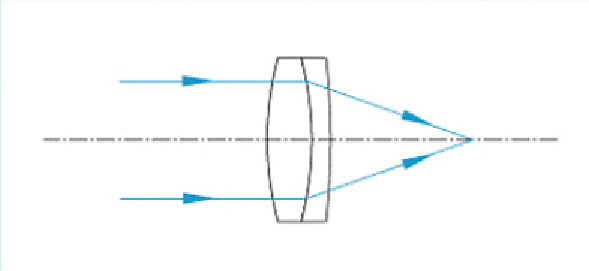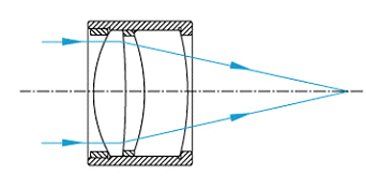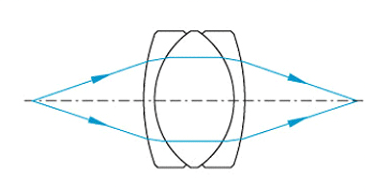Achromatic lenses are a good choice for any demanding optical application because they have substantially better performance than spherical single lenses. Achromatic double bonded lenses are sufficient for most applications with infinite conjugation, and double bonded lenses are an ideal choice for finite conjugation.
However, the adhesive used in these optical components reduces their damage threshold and limits their usability in high-power systems. Dual lens with air separation is an ideal choice for high-power applications because their damage threshold is greater than that of achromatic laminated lenses. In addition, double laminated lenses with air gaps have two more design variables than double laminated lenses, as the inner surface of the lens does not need to have the same curvature. These additional variables are due to the fact that the air gap dual lens outperforms the double bonded lens in terms of transmission wavefront error, spot size, and aberration. However, spatially spaced doublet lenses are also more expensive than double laminated lenses.
Achromatic triple lenses can be designed for both finite and infinite conjugate ratios. These triple lenses have a low refractive index optical element in the middle, which is glued between two identical high refractive index external optical elements. They can correct axial and lateral chromatic aberration, and their symmetrical design has better performance than laminated lenses.
Double laminated lens:
Achromatic dual lens has more advantages than simple single lens. They include color difference reduction, improved off-axis performance, and smaller focal spot size. These doublet lenses have a positive focal length and are optimized for wireless conjugation ratio.

Air gap dual lens:
Air gap dual lens has better performance than double laminated lens because their lenses are separated. These optical components are ideal choices for high-power applications because their damage threshold is higher than that of double laminated lenses. These doublet lenses have a positive focal length and are optimized for infinite conjugate ratios.

Double lens pairs:
Achromatic dual lens pairs have the advantages of achromatic lenses and are optimized for finite conjugate ratios. These lenses are an ideal choice for image relay and magnification systems.

Achromatic triple lens:
Achromatic triple lens has better performance than achromatic double lens. A chromatic aberration correcting triple lens is a simple lens that can correct all major chromatic aberration. Steinheil triple lenses are optimized for finite conjugate ratios, while Hasting triple lenses are optimized for infinite conjugate ratios.

Achromatic lens is a specially designed optical element aimed at reducing or eliminating chromatic aberration caused by material dispersion. Color difference is an optical phenomenon in which when light of different wavelengths (colors) passes through a lens, due to the dispersion of the material, they will focus at different positions, resulting in colored edges or blurs during imaging. Achromatic lenses improve imaging quality by combining two or more materials with different refractive indices and dispersion characteristics to counteract this dispersion effect.
application area
Achromatic lenses are widely used in optical systems that require high-quality imaging, including:
- Astronomical telescope:Used to improve the clarity and accuracy of celestial observation.
- photographic lens:Used to improve the imaging quality of photos, reduce color fringing and blurring.
- microscope:Used to improve the clarity of sample observation in biological and materials science research.
- LASER SYSTEM:In some laser systems, it is used to improve the quality and accuracy of the beam.
advantage
- High imaging quality:By reducing or eliminating color differences, clearer and more accurate imaging results can be obtained.
- WIDELY:Suitable for various optical systems, it improves the performance and reliability of these systems.
- design flexibility:Specific optical requirements can be met by selecting different materials and design parameters.
Achromatic lenses are an indispensable part of high-performance optical systems. Through their unique design and material combination, they significantly improve imaging quality and meet high standards in fields such as scientific research, astronomical observation, photography art, and industrial applications.
| Achromatic lenses can process conventional indicators | |
| material | optical glass |
| Product Category | achromatic lens |
| Processing diameter (mm) | 5-300 |
| Diameter tolerance (mm) | ±0.03 |
| Thickness tolerance (mm) | ±0.03 |
| Surface smoothness (American standard) | 60-40 or 20-10 |
| Surface Accuracy | λ/8 @ 632.8nm or higher |
| Focal length error | ±2% |
| Optical aperture | >90% |
| core shift | <3 ‘or higher |
| chamfer | 0.2mmX45° |
| coating film | 按需求定制Customize according to demand |







![1678850150623f0c8f1684c-1024x1024[1] 1678850150623f0c8f1684c-1024x1024[1]](https://asphericoptics.com/wp-content/uploads/2024/09/1678850150623f0c8f1684c-1024x10241-1-1024x701.jpg)